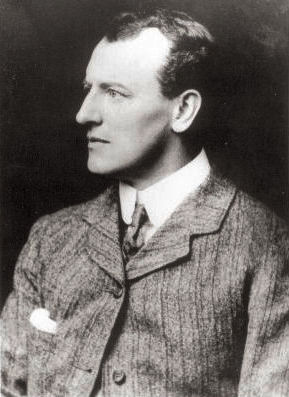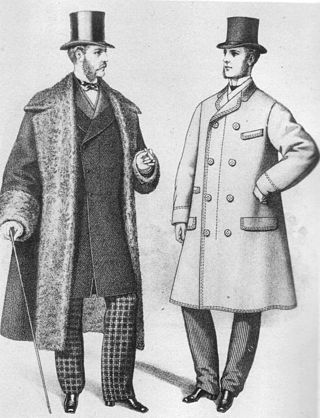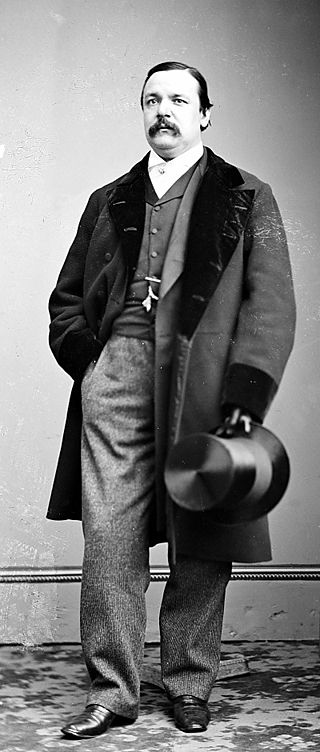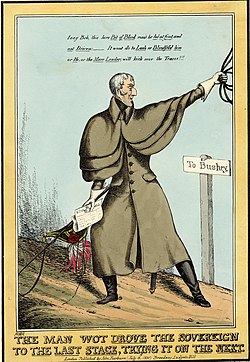
The kimono is a traditional Japanese garment and the national dress of Japan. The kimono is a wrapped-front garment with square sleeves and a rectangular body, and is worn left side wrapped over right, unless the wearer is deceased. The kimono is traditionally worn with a broad sash, called an obi, and is commonly worn with accessories such as zōri sandals and tabi socks.

A surcoat or surcote is an outer garment that was commonly worn in the Middle Ages by soldiers. It was worn over armor to show insignia and help identify what side the soldier was on. In the battlefield the surcoat was also helpful with keeping the sun off the soldier and their armor which helped prevent heat stroke and heat exhaustion. The name derives from French meaning "over the coat", a long, loose, often sleeveless coat reaching down to the feet.

There are typically two types of clothing worn in Japan: traditional clothing known as Japanese clothing, including the national dress of Japan, the kimono, and Western clothing, which encompasses all else not recognised as either national dress or the dress of another country.

A coat is typically an outer garment for the upper body, worn by either gender for warmth or fashion. Coats typically have long sleeves and are open down the front, and closing by means of buttons, zippers, hook-and-loop fasteners, toggles, a belt, or a combination of some of these. Other possible features include collars, shoulder straps, and hoods.

Sidney Edward Paget was a British artist of the Victorian era, best known for his illustrations that accompanied Arthur Conan Doyle's Sherlock Holmes stories in The Strand Magazine.

An overcoat is a type of long coat intended to be worn as the outermost garment, which usually extends below the knee. Overcoats are most commonly used in winter when warmth is more important.

Fashion in the 1890s in European and European-influenced countries is characterized by long elegant lines, tall collars, and the rise of sportswear. It was an era of great dress reforms led by the invention of the drop-frame safety bicycle, which allowed women the opportunity to ride bicycles more comfortably, and therefore, created the need for appropriate clothing.

1870s fashion in European and European-influenced clothing is characterized by a gradual return to a narrow silhouette after the full-skirted fashions of the 1850s and 1860s.

A deerstalker is a type of cap that is typically worn in rural areas, often for hunting, especially deer stalking. Because of the cap's popular association with the fictional detective Sherlock Holmes, it has become stereotypical headgear for a detective, especially in comical drawings or cartoons along with farcical plays and films.

The jūnihitoe, more formally known as the itsutsuginu-karaginu-mo (五衣唐衣裳), is a style of formal court dress first worn in the Heian period by noble women and ladies-in-waiting at the Japanese Imperial Court. The jūnihitoe was composed of a number of kimono-like robes, layered on top of each other, with the outer robes cut both larger and thinner to reveal the layered garments underneath. These robes were referred to as hitoe, with the innermost robe – worn as underwear against the skin – known as the kosode. Hakama were also worn as underwear with the kosode; over time, the two would gradually become outerwear, with the kosode eventually developing into the modern-day kimono.

A banyan is a garment worn by European men and women in the late 17th and 18th century, influenced by the Japanese kimono brought to Europe by the Dutch East India Company in the mid-17th century. "Banyan" is also commonly used in present-day Indian English and other countries in the Indian subcontinent to mean "vest" or "undershirt".

An over-frock coat is a formal overcoat designed to be worn over a frock coat if needed in cold weather. A top-frock coat may also be worn over a frock coat in milder weather. Shaped like the body coats popular in the Victorian and Edwardian periods, the over-frock coat was cut in essentially the same way as the frock coat that was worn under it, although it would be larger overall to accommodate the frock-coat worn underneath. Like the frock coat, the over-frock would typically be single-breasted, with step lapels for informal occasions like business, and double-breasted with pointed lapels for formal occasions – weddings, funerals, balls, etc. The top-frock was usually double breasted. The formal variety was sometimes called a Prince Albert overcoat. The Prince Albert top frock, from the later half of the 19th century, originally had a three-inch-wide velvet collar, and flap pockets at the hip, until 1893, when it became even more fitted, longer, and double-breasted.

Fashion in the period 1900–1909 in the Western world continued the severe, long and elegant lines of the late 1890s. Tall, stiff collars characterize the period, as do women's broad hats and full "Gibson Girl" hairstyles. A new, columnar silhouette introduced by the couturiers of Paris late in the decade signaled the approaching abandonment of the corset as an indispensable garment.

Fashion from 1910 to 1919 in the Western world was characterized by a rich and exotic opulence in the first half of the decade in contrast with the somber practicality of garments worn during the Great War. Men's trousers were worn cuffed to ankle-length and creased. Skirts rose from floor length to well above the ankle, women began to bob their hair, and the stage was set for the radical new fashions associated with the Jazz Age of the 1920s.

The Ulster is a Victorian working daytime overcoat, with a cape and sleeves.

The kosode was a type of short-sleeved Japanese garment, and the direct predecessor of the kimono. Though its component parts directly parallel those of the kimono, its proportions differed, typically having a wider body, a longer collar and narrower sleeves. The sleeves of the kosode were typically sewn to the body entirely, and often featured heavily rounded outer edges.

A statue of Sherlock Holmes by the sculptor John Doubleday stands near the supposed site of 221B Baker Street, the fictional detective's address in London. Unveiled on 23 September 1999, the sculpture was funded by the Abbey National building society, whose headquarters were on the purported site of the famous address. As no site was available on Baker Street itself the statue was installed outside Baker Street tube station, on Marylebone Road. Doubleday had previously produced a statue of Holmes for the town of Meiringen in Switzerland, below the Reichenbach Falls whence the detective fell to his apparent death in the 1893 story "The Final Problem".

A cape is a clothing accessory or a sleeveless outer garment which drapes the wearer's back, arms, and chest, and connects at the neck.

Japanese clothing during the Meiji period (1867–1912) saw a marked change from the preceding Edo period (1603–1867), following the final years of the Tokugawa shogunate between 1853 and 1867, the Convention of Kanagawa in 1854 – which, led by Matthew C. Perry, forcibly opened Japanese ports to American vessels, thus ending Japan's centuries-long policy of isolation – and the Meiji Restoration in 1868, which saw the feudal shogunate dismantled in favour of a Western-style modern empire.



























